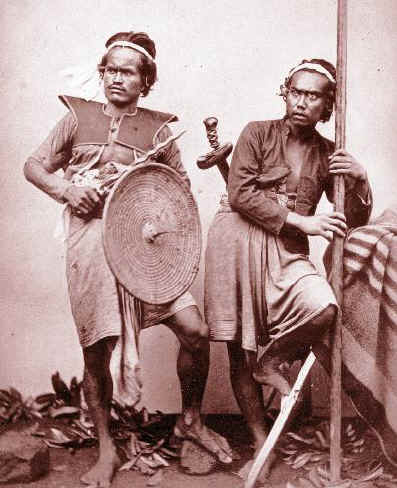
 |
|
|
|
|
#1 |
|
Keris forum moderator
Join Date: Aug 2006
Location: Nova Scotia
Posts: 7,250
|
Thanks Alan, very interesting fuel for thought.

|
|
|

|
|
|
#2 |
|
Vikingsword Staff
Join Date: Nov 2004
Posts: 6,376
|
Well, I took a trip through Tammens and found a relatively consistent range of sizes . Unfortunately Tammens does not even guess at the age of the hilts shown but there seem to be essentially two sizes; 10-12 cm. and 14-16 cm.
You both are correct that my version of the Jawa grip is inefficient for these blades; and the blade example I used to illustrate was of the humped ganja style thus enhancing any chance of acheiving the Jawa grip. This brings me to another question; why are not Bali keris more securely attached to their grips? I realise that as a collector my keris grips would be more loosely attached to prevent splitting or damaging the handles; but what about in real conditions; what about blade twist during use? One would think that without the stabilising effect of the hand in the Jawa style grip that the Bali keris would have gone the way of the Moro pieces; into a flattened tang to prevent twist. 
|
|
|

|
|
|
#3 |
|
Member
Join Date: May 2006
Posts: 7,085
|
Problem is Rick, we don't really know how Bali handles were attached way back when they were actually using the things.
I've had a couple of Bali keris that had the handles fixed with something like damar, so maybe this was general 100 years+ ago, but I don't know for sure. If damar was used it would have given a very firm fix to the handle. Any tang that is set in damar will split the handle and bend the tang and blade before it ever comes loose. Sword tangs were set in damar, and those tangs are often not all that long. No way you can get a tang set in damar free without heating the blade to soften the damar. This being so, there was no need to go to the Moro keris system.In any case, Bali blades are not near as substantial as Moro type blades. |
|
|

|
|
|
#4 |
|
Vikingsword Staff
Join Date: Nov 2004
Posts: 6,376
|
I was unaware of Damar Alan; a plant resin ?
I guess this brings up the question of differing fighting systems with regards to Jawa and Bali. The different grip could possibly be used for the overhand blow, or strike as well as the thrust. |
|
|

|
|
|
#5 |
|
Keris forum moderator
Join Date: Aug 2006
Location: Nova Scotia
Posts: 7,250
|
Alan may be right about this. I also have a Bali keris that was fastened with some natural resin materal like damar and it was certainly a hardy grip. It took quite a bit of heating and wiggling to remove it. I would image that hilt would have remained extremely stable through use without ever gripping the actual blade.
|
|
|

|
|
|
#6 |
|
Member
Join Date: Jul 2005
Location: Toronto, Canada
Posts: 1,242
|
Hello,
The last three comments above brought to mind this picture  from http://old.blades.free.fr/home.htm from http://old.blades.free.fr/home.htmIt shows a grip different from that of Jawa keris, as well as a common? wear of Balinese keris. Regards, Emanuel |
|
|

|
|
|
#7 |
|
Member
Join Date: May 2006
Posts: 7,085
|
Yes Emanuel, it does.
Problem is that these pics used to get set up and posed by the photographer. I don't think they can be regarded as 100% representative of reality. Actually, I've seen this pic somewhere. Can you save me from looking and give us a date? |
|
|

|
|
|
#8 |
|
Member
Join Date: Jul 2005
Location: Toronto, Canada
Posts: 1,242
|
Hello Alan,
You are quite right that the pose may be staged. The picture is on the website I indicated, and I remember seeing it in a book as well, but I cannot recollect which one at the moment. Unfortunately I cannot provide a date for it, as I do not even know its source. I realize that the relief depiction on the [forgot the name] temple shows the Empu/Deity gripping the blade between his fingers, but I vaguely recall seeing a tapestry or painting of a Javanese battle which showed the warriors grasping the ukiran in a closed fist. I will look for it. Wouldn't old paintings/depictions offer a reliable look at common wear? Of course, the subjects of these depictions would have dressed for the occasion I guess... The few keris I have are of a Javanese style, so I cannot contribute to the discussion of Balinese hilts. I was thinking, however that a large Solo ukiran could also be held quite firmly without pinching the gonjo. It feels comfortable in hand. I have seen the grip you showed in a few books as well, and I understand that it is the accepted way of holding Jawa keris, but could this be a result of dance poses. I'm sorry to ramble like this, but pinching the gonjo between the index finger and the thumb seems like a very delicate way of gripping a weapon, akin to the intricate hand/finger movement in dances. I do not practice any martial art with weapons, so these are purely amateurish conjectures on my part. Warn regards, Emanuel |
|
|

|
 |
|
|